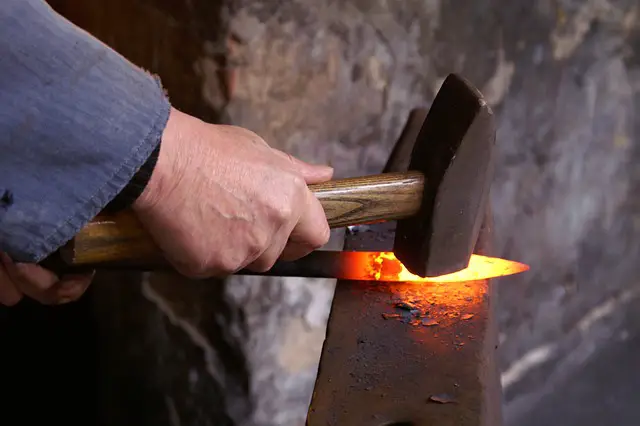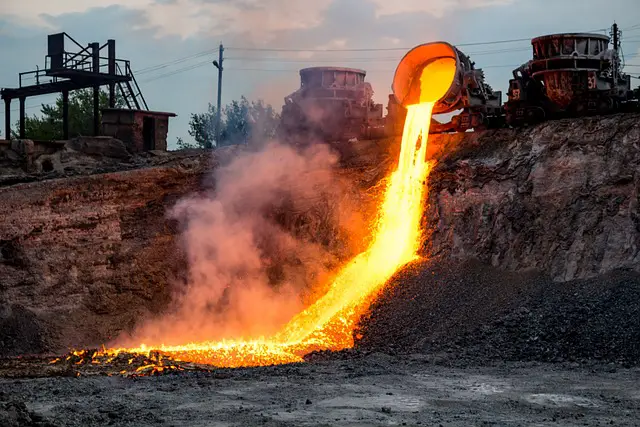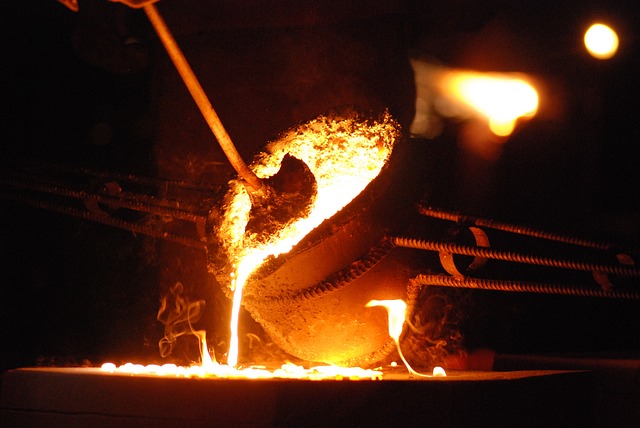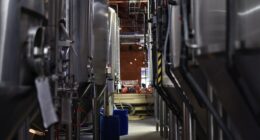Forged iron is made by heating and shaping a solid piece of iron, resulting in a stronger, more durable product. Cast iron is made by pouring molten iron into a mold, resulting in a more brittle product that can be more complex in shape.
What is Forged Iron?
(Image by Dirk Hoenes from Pixabay )

Forged iron is a type of iron that has been heated and then pounded or worked by a blacksmith. This process gives the iron more strength and hardness than cast iron. Forged iron can be used to create tools, weapons, and other objects.
What is Cast Iron?
(Image by arodsje from Pixabay )

Cast iron is a type of iron that has been melted and poured into a mold. It is then allowed to cool and solidify. The resulting product is a strong, durable material that is often used in the construction of buildings and bridges.
Forged Iron Vs. Cast Iron
Forged iron and cast iron are two different methods of manufacturing iron products, and they have several key differences:
Manufacturing process: Forged iron is made by heating a solid piece of iron or steel and then shaping it with a hammer or press, while cast iron is made by melting iron and pouring it into a mold.
Strength: Forged iron is generally stronger and more durable than cast iron, as the hammering or pressing process compresses the iron, making it less likely to have defects or weaknesses. Cast iron is more brittle and may crack or break under stress.
Surface finish: Forged iron has a rougher surface finish than cast iron, as it is not poured into a mold and does not have the smooth, polished look of cast iron.
Shape complexity: Cast iron can be made into more complex shapes than forged iron, as it can be poured into a mold to create intricate designs. Forged iron is limited by the size and shape of the starting material and the hammer or press used to shape it.
Cost: Forged iron is generally more expensive than cast iron, as the manufacturing process is more labor-intensive and time-consuming.
Forged iron is stronger and more durable than cast iron, but cast iron can be made into more complex shapes and is less expensive to manufacture. The choice between forged iron and cast iron will depend on the specific application and the desired characteristics of the final product.
Which is better? Forged or Cast Iron?
There are a few key differences between forged and cast iron that can help you decide which is better for your needs. Forged iron is made by heating and shaping the metal with tools, while cast iron is made by pouring molten metal into molds.
Forged iron is usually stronger and more durable than cast iron, but it is also more expensive. Cast iron is less likely to break or crack, but it is not as strong overall. If you need a very strong and durable piece of metal, forged iron is the better choice. However, if you’re working on a budget, cast iron may be a better option.
What are the advantages and disadvantages of forged iron?
Forged iron has been used for centuries in various applications, from weapons and tools to architectural elements and decorative items. Here are some of its advantages and disadvantages:
Advantages:
- Strength and durability: Forged iron is known for its strength and durability. It can withstand high levels of stress and can last for a long time with proper maintenance.
- Customization: Forging allows for customization of the iron’s shape and size, making it ideal for various applications.
- Aesthetics: Forged iron has a distinctive look that many people find appealing. It can be used to create intricate and detailed designs that are difficult to achieve with other materials.
- Heat resistance: Forged iron can withstand high temperatures, making it ideal for use in applications that involve heat, such as grills and fireplaces.
Disadvantages:
- Cost: Forged iron is generally more expensive than other materials, such as cast iron or steel.
- Rusting: If not properly maintained, forged iron can rust over time. This can lead to corrosion and weakened structural integrity.
- Weight: Forged iron is heavy, which can make it difficult to work with and transport.
- Time-consuming: Forging iron is a time-consuming process that requires specialized equipment and expertise. This can make it difficult to produce large quantities of forged iron items quickly.
- Overall, forged iron is a strong and durable material that is ideal for many applications. However, its cost and maintenance requirements may make it less practical for some projects.
What are the advantages and disadvantages of cast iron?
Cast iron is a type of iron that is made by melting iron and adding various alloys and impurities to give it specific properties. Here are some of the advantages and disadvantages of cast iron:
Advantages:
- Durability: Cast iron is known for its durability and strength. It can withstand high levels of stress and can last for a long time with proper maintenance.
- Heat retention: Cast iron can retain heat well, making it ideal for cooking applications such as skillets and Dutch ovens.
- Versatility: Cast iron can be used in a variety of applications, from decorative elements to industrial machinery.
- Cost-effective: Cast iron is generally less expensive than other materials, such as stainless steel.
Disadvantages:
- Brittle: Cast iron can be brittle and prone to cracking under stress, particularly if it is not properly maintained.
- Rusting: If not properly maintained, cast iron can rust over time. This can lead to corrosion and weakened structural integrity.
- Weight: Cast iron is heavy, which can make it difficult to work with and transport.
- Slow heating and cooling: Cast iron heats and cools slowly, which can make it less practical for certain cooking applications.
Cast iron is a versatile and cost-effective material that is ideal for many applications. However, its brittleness and susceptibility to rust may make it less practical for certain applications.
What are the things made with forged iron?
Forged iron can be used to make a variety of objects, from tools and weapons to architectural and decorative elements. Some common items made with forged iron include:
- Knives and swords: Forged iron can be used to create strong and durable blades for knives and swords.
- Tools: Forged iron is commonly used to make tools such as hammers, chisels, and tongs due to its strength and durability.
- Architectural elements: Forged iron can be used to create decorative elements for buildings, such as railings, gates, and fences.
- Furniture: Forged iron can be used to create durable and stylish furniture pieces, such as beds, tables, and chairs.
- Sculptures and art: Forged iron can be shaped and molded into intricate and detailed designs, making it a popular choice for sculptures and art pieces.
- Cookware: Forged iron can be used to create cookware such as skillets and Dutch ovens due to its heat resistance and durability.
- Automotive parts: Forged iron is used in the production of various automotive parts such as engine components and suspension parts due to its strength and durability.
Overall, forged iron is a versatile material that can be used in a variety of applications due to its strength, durability, and malleability.
What are the things made with cast iron?
Cast iron is a material that is produced by melting iron ore in a furnace and then pouring it into a mold. It is a strong, durable material that has been used for centuries for a variety of purposes. Some of the most common things that are made with cast iron are cookware, pipes, and machine parts.
Cast iron cookware is a popular choice for many people because it is affordable and easy to care for. Cast iron pots and pans can be used on any type of stovetop, including gas, electric, or induction. They are also oven-safe, so you can use them for baking or roasting. Cast iron skillets are especially popular because they retain heat well and can be used to create a variety of dishes, from breakfast foods to desserts.
Pipes made from cast iron are commonly used in plumbing applications because they are strong and durable. They can withstand high temperatures and pressures, making them ideal for carrying hot water or steam. Cast iron pipes can also be used in sewage systems because they resist corrosion from acidic waste products.
Machine parts made from cast iron are often used in engines and other heavy machinery because they can withstand a lot of wear and tear. Cast iron blocks and cylinder heads are common components in engines, while gears and pulleys made from cast iron are often used in heavy machinery such as construction equipment.
Featured Image By – Image by Enlightening Images from Pixabay








